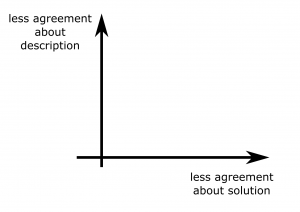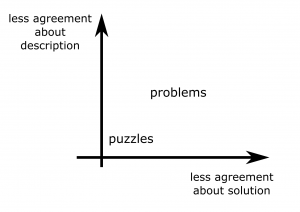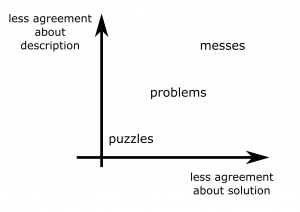Real world problems come in a range of shapes, sizes and complexity. Sometimes it is obvious what the problem is, and what a likely solution is going to be – in which case you may even be able to find a solution in your head. In other cases, you may need to look to use a computer or similar tool to find a solution. But what about complex problems where it’s not even entirely clear what the problem let alone what a solution could be. In this post I look at a few ways of defining complex problems. If you can recognise which problem type your dealing with, you can start thinking of ways to solve it.
Read more about approaches for tackling complex problems in Tools for Thinking
How Complex is Your Problem?
We can think of a problem situation in terms of the its formulation and solution. We can put those two concepts on a set of axes: More complex problems are towards the top right of the axes: these are more difficult to define, and may have multiple solutions. Simpler problems are towards the bottom left. These are easier to define or formulate, and have a more straightforward solution.

Puzzles
First let’s consider problems that are easier to formulate and have a clear solution. These ‘puzzle-like’, just like jigsaw puzzles have a well-defined solution, but there might be multiple ways to reach that solution. With jigsaws you can start at the edges and work your way to the centre, start at the centre and work your way out, or perhaps begin with the corners. The important thing with these puzzles is that there is agreement of what the problem is, and what the solution would look like. Just like with a jigsaw, actually getting to the solution of a puzzle can still be a challenge.

Problems
As we move along and up our axes we get to problems that are perhaps a little more difficult to formulate exactly, and with less agreement about what a best solution might look like. An example might be a question of how many staff a shop should have on a given day. Here we can probably agree about the core issue of staffing, but there are a number of ways we can formulate the problem. We would probably need to make some assumptions before we can come to a solution – we could assume that we are looking at a normal weekday, with no deliveries scheduled, and not during a sale or pre-Christmas rush. With a ‘problem’ we can have a fairly well defined idea of the question, but with a less clear idea of what success or correct looks like.

Messes
Finally we come to ‘messes’, also known as ‘wicked problems’. These are at the extreme top right of our axes and exist where there is much uncertainty or disagreement about what the problem is, let alone what might be the best way to tackle it. For messes there are often multiple points of view or possible definitions of the problem, and there may not even be a solution. In a mess it may be difficult to see what exactly you would want out of a solution, and you may be uncertain about an outcome. There is also often risk to the parties involved in the mess. Extending the example of our shop in ‘problems’, a mess might be question of where to locate a new shop. Clearly this is a difficult problem with many possible solutions, with significant risk to the shop owners. Problems can also become messy if they involve many interconnected, independently complex systems.
